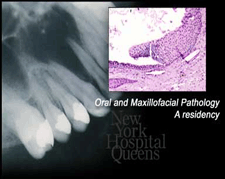المقالات
Lymphoid Hyperplasia

Lymphoid hyperplasia is not a disease or a tumor, but simply a term we use to represent enlarged tissue masses. Normal lymphoid tissue is found in your lymph nodes and tonsils. These tissues act as your body's first line of defense against infections. Lymphoid hyperplasia exists when these masses suddenly form and enlarge in locations not typical for lymphoid tissue, such as on the rear top surface of the mouth or along the sides of the tongue. They can also form on the gums, the floor of the mouth, at the back of the throat or the inside of the cheeks. The enlarged masses usually form in response to some form of irritation, such as an infection in the immediate area or a generalized upper respiratory infection. Tissue masses associated with lymphoid hyperplasia may be tender and reddened, and range in size from small growths of 2 to 5 centimeters (called tissue tags) to nodules up to a centimeter or more in diameter.
* Treating the infection will typically cause the tissue to return to normal size.
microscope to be sure it is not cancerous. This is called a biopsy.
* To avoid continued irritation, we may surgically remove the masses that do not regress on their own.
